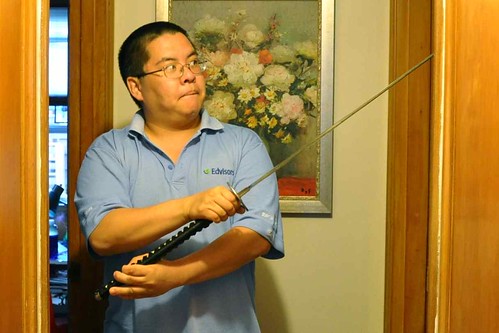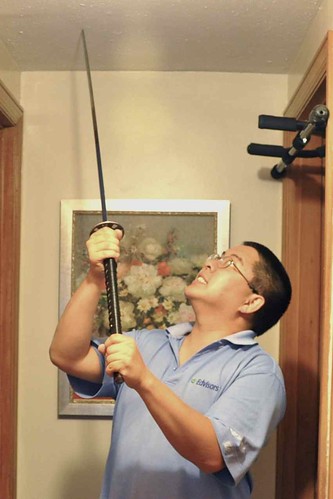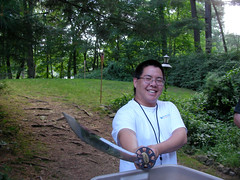While a bunch of folks were at Blogworld in Vegas this past weekend, I and a few other intrepid seekers got on a plane at Logan Airport in Boston to head to… Dayton, Ohio! Instead of the Strip, we headed to the Dayton Quest Center for a seminar with Stephen K. Hayes called Evocation.
It’s nearly impossible for me to describe exactly what Evocation was or what happened in a general sense because Evocation was an intensely personal exploration of understanding our self-imposed limits and how to shatter the barriers of what’s holding us back from achieving true success in the world. Evocation was a completely different seminar for each person who attended because every person in the room faced different, unique challenges in their lives. The areas of exploration and growth that I needed to explore, the questions I needed answers to were very different than the ones of the person sitting next to me.
Evocation was exactly as it sounds – a seminar that evoked reactions, thoughts, and insights about our problems with our own minds, memories, emotions, and experiences acting as both student and teacher, both problem and solution. It was an esoteric seminar in the most powerful sense of the word esoteric – all the good stuff was all direct experience rather than textbook learning, which is another reason why it’s so hard to describe.
Here’s an example of esoteric. Let’s take something that a lot of people haven’t eaten: a lychee nut. If you’ve had lychees, all I have to do is say the word and it evokes the taste, scent, and experience of eating one. If you’ve never had a lychee, no amount of verbiage in this post will ever come close to granting you the whole, authentic experience of biting into one. The only way you can truly understand a lychee nut is to have the direct experience. I can tell you perhaps a local store near you that sells them, or another name under which it might be sold, but in the end, the experience of biting into one and the wonderful taste it imparts (if it’s fresh and ripe) is something you can only experience.
In fact, the more I might try to blog about a lychee, the less likely you might be to try it. I might stumble upon an explanation of a lychee that’s good enough for the casually curious, and once you’ve got that explanation, you’ll pass it by. Your mind will say, well, we have a general idea of what it’s probably like (even though you have no idea whatsoever), so it’s not worth running out to the store to get one.
So rather than write about Evocation any more or how life changing an experience it was for me – heck, I came away with an entirely new sense of identity and self, a better, more powerful version of the me that got on a plane in Boston last week – I’ll only suggest that the next time Stephen K. Hayes offers a seminar like Evocation in the future, screw Blogworld (or whatever else is happening then) and go to Dayton to train with him. The experience will be unlike anything else you’ve ever done, and the tools you’ll get to make your life better, make your business more successful, and make you happier as a human being will be worth it.
You will emerge with an astonishingly clear vision of who you are supposed to be in this life, the true, authentic, heroic self that is inside of you right now, silently screaming to be free.
I’ll close for now by extending my sincerest thanks to my teachers, Mark Davis of the Boston Martial Arts Center, and Stephen K. Hayes, for an incredible Evocation experience that was infinitely more valuable than anything I might have won in Vegas, and a hearty “see you next time!” to my fellow Evocation participants.
There will be much more to come in the days ahead as the lessons of Evocation settle into my mind and begin to produce the results I want to create. I hope you’ll stick around as we explore together what’s possible.
Did you enjoy this blog post? If so, please subscribe right now!
Enjoyed it? Please share it!
Get this and other great articles from the source at www.ChristopherSPenn.com





 Let me tell you a story about fear, from the martial arts. A long time ago, a decade ago, the test in my dojo to go from green belt (intermediate) to brown belt (advanced) was incredibly rigorous. The test was typically three parts. In the first part, you as the candidate faced off against one of the senior black belts in the dojo. They had a shinai – a four foot bamboo practice sword that, while it wouldn’t cut flesh or break bones, would still hurt like hell. Their mission was to try and beat you with the stick for what seemed like an eternity. Your mission as the candidate was to escape and evade them as much as possible – not even to defend or counterattack (which was usually met with a stick to the face) – just to evade and escape.
Let me tell you a story about fear, from the martial arts. A long time ago, a decade ago, the test in my dojo to go from green belt (intermediate) to brown belt (advanced) was incredibly rigorous. The test was typically three parts. In the first part, you as the candidate faced off against one of the senior black belts in the dojo. They had a shinai – a four foot bamboo practice sword that, while it wouldn’t cut flesh or break bones, would still hurt like hell. Their mission was to try and beat you with the stick for what seemed like an eternity. Your mission as the candidate was to escape and evade them as much as possible – not even to defend or counterattack (which was usually met with a stick to the face) – just to evade and escape.